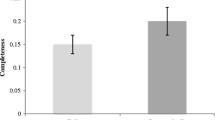Abstract
The present study, using schematic sport diagrams, examined the perceptual chunking hypothesis (Chase & Simon, 1973a; 1973b) that visual patterns are represented by labels in a limited-capacity, short-term memory. This study, which employed three subject-skill levels and an interpolated processing paradigm, indicated that for experts, information extracted during an 8-second study period has great longevity and durability. Interpolated processing demands, along with an additional encoding activity of a second diagram presentation, had minimal effects on recall performance. This evidence supports the position that meaningful and familiar information abstracted during a brief exposure period is immediately processed in long-term memory, thus facilitating subsequent retrieval.
Similar content being viewed by others
References
Brown, J. (1958). Some tests of the decay theory of immediate memory.Quarterly Journal of Experimental Psychology, 10, 12–21.
Charness, N. (1976). Memory for chess positions: Resistance to interference.Journal of Experimental Psychology: Human Learning and Memory, 2, 641–653.
Chase, W.G., & Simon, H.A. (1973a). This mind’s eye in chess. In W.G. Chase (Ed.),Visual information processing. New York: Academic Press.
Chase, W.G., & Simon, H.A. (1973b). Perception in chess.Cognitive Psychology, 4, 55–81.
Egan, D.E., & Schwartz, B.J. (1979). Chunking in recall of symbolic drawings.Memory & Cognition, 7, 149–158.
Frey, P.W., & Adesman, P. (1976). Recall memory for visually presented chess positions.Memory & Cognition, 4, 541–547.
Miller, G.A. (1956). The magical number seven, plus or minus two: Some limits on our capacity for processing information.Psychological Review, 63, 81–97.
Peterson, L.R., & Peterson, M.J. (1959). Short-term retention of individual verbal items.Journal of Experimental Psychology, 58, 193–198.
Simon, H.A., & Chase, W.G. (1973). Skill in chess.American Scientist, 61, 394–403.
Simon, H.A., & Gilmartin, K.A. (1973). Simulation of memory for chess positions.Cognitive Psychology, 5, 29–46.
Author information
Authors and Affiliations
Additional information
This research was partially supported by a Grant-in-Aid of Research from Sigma Xi, The Scientific Research Society, to Daniel J. Garland. This research was presented at the 98th Annual Convention of the American Psychological Association in Boston, Massachusetts, August, 1990. We wish to thank Bruce K. Britton for his helpful comments and suggestions on this article, and to express special thanks to Milton H. Hodge for assistance in the preparation of the stimulus materials used in this research.
Rights and permissions
About this article
Cite this article
Garland, D.J., Barry, J.R. Effects of interpolated processing on experts’ recall of schematic information. Current Psychology 10, 273–280 (1991). https://doi.org/10.1007/BF02686899
Accepted:
Issue Date:
DOI: https://doi.org/10.1007/BF02686899




